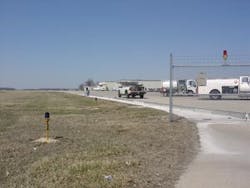The Environmental Protection Agency (EPA) recently provided clarification of the spill containment requirements for mobile fuel trucks, including those used for aircraft refueling operations. Meeting the challenge of mobile fuel truck spill containment requires careful consideration in order to develop a system that is cost-effective and suitable for the current and future operations of a facility. Here are some considerations, along with a review of the industry/EPA discussion on load racks.
On July 17, 2002 EPA issued a final rule amending the Oil Pollution Prevention regulation, promulgated under the authority of the Clean Water Act, which included an amendment to the compliance deadlines for a Spill Prevention Control and Countermeasures (SPCC) Plan and implementation of the plan.
In a letter dated March 8, 2005 to the aviation industry, the EPA states that mobile fuel trucks are mobile or portable storage containers, and are therefore subject to the SPCC rule requirements, including secondary containment. The method for evaluating how to achieve compliance will depend on a spectrum of issues which need to be considered.
The issues include:
- facility drainage patterns;
- the condition of the pavement where trucks are parked;
- available options for alternative truck parking locations;
- the airport’s general permit for stormwater discharge;
- future development plans for the facility; and
- conflicts with other tenant’s use of the parking areas.
Mobile Fuel Truck Design Considerations
Considerations for the design of a containment structure should include functionality, flexibility, ease of use, and, most certainly, cost. During the design phase, consider future plans for the facility, such as ramp renovations or new construction. Incorporating containment facilities in future construction plans may prove to be the most cost-effective approach.
For existing facilities, weather (particularly snow and rain) and current use of the facility (i.e., aircraft and vehicle traffic patterns) are important considerations when evaluating if a portable or temporary containment system will work best. Designs may take advantage of existing drainage controls or physical features already in place at the facility, such as concrete curbing, oil/water separators at fuel farms, or drainage into retention basins. (Before settling on a design for a facility, the containment capacity should be checked to make sure the correct volume will be provided, including sufficient freeboard for precipitation events.)
The airport may also want to review the design before proceeding with a compliance schedule to make sure that it agrees with the location, use of materials, and overall layout.
Containment
The SPCC rule requires that a facility provide appropriate containment and/or diversionary structures or systems for mobile fuel trucks. This may include dikes, berms, or retaining walls sufficiently impervious to contain oil; culverting, gutters, or other drainage systems, weirs, booms or other barriers; spill diversion ponds; retention ponds, or sorbent materials.
Regardless of the spill prevention system used, careful consideration must be given to a variety of factors to ensure that an effective, low cost and reliable solution is employed to achieve compliance.
Defining a Load Rack
Meanwhile, AAAE, NATA, ACI-NA, and ATA have been working as a coalition to develop guidance with EPA on the final SPCC rule related to fuel loading/unloading racks (otherwise known as a "load rack").
Historically, the provisions of 40 CFR 112.7(e)(4) established requirements for SPCC plans that were specific to onshore facility tank car and tank truck loading/unloading rack areas and specifically addressed rack area drainage. The use of the term "rack" indicated that a loading/unloading rack structure of some kind was necessary to trigger application of the SPCC requirements. In the final SPCC rule (Section 112.7(h)(1), the language suggests that all areas in which an oil transfer occurs may trigger the SPCC requirements regardless if a load rack exists or not at the facility.
Section 112.7(h)(1) of the final SPCC rule requires that containment for a facility tank car and tank truck loading/unloading rack (excluding off-shore facilities) must be designed to hold at least the maximum capacity of any single compartment of a tank car or tank truck loaded or unloaded at the facility. For a single tank, installing spill containment would be cost-prohibitive and unnecessary - not to mention the absence of a load rack.





